Performance for Surface Firmness and Stability
Table 1 identifies the 11 test surface materials, the dates of installation, and the date of the initial and final testing of surfaces at the Wetlands at Bradford Woods in Martinsville, Indiana:
| Table 1. Surface Material, Installation, Initial and Final Data Collection | |||
| Surface Material | Date of Installation | Date of Initial
Data Collection
|
Data of Final
Data Collection
|
| ¼ inch minus limestone | August 9, 2007 | August 16, 2007 | November 02, 2011 |
| ¾ inch minus & ¼ inch minus limestone | August 9, 2007 | August 16, 2007 | November 02, 2011 |
| ¾ inch minus limestone | August 1, 2007 | August 16, 2007 | November 02, 2011 |
| Klingstone 400 | June 19, 2007 | June 21, 2007 | November 02, 2011 |
| Polypavement | July 3, 2007 | June 6, 2007 | November 02, 2011 |
| Soiltac Liquid Mix-In | June 27, 2007 | July 6, 2007 | November 02, 2011 |
| Soiltac Liquid Topical | June 27, 2007 | July 6, 2007 | November 02, 2011 |
| Soiltac Powder Mix-In | June 27, 2007 | July 6, 2007 | November 02, 2011 |
| Soiltac Powder Topical | June 27, 2007 | July 6, 2007 | November 02, 2011 |
| Stabilizer | June 21, 2007 | July 6, 2007 | November 02, 2011 |
| StaLok | June 21, 2007 | July 6, 2007 | November 02, 2011 |
The surfaces were tested three times a year (with the exception of 2007 and 2010 when each of the surfaces were tested twice), over 51 months. The testing occurred in varying seasons to capture the way in which the climate change affects the surfaces. The firmness and stability means and standard deviations are important elements of the data collection and reporting process. However, a potentially more telling figure may reside in the minimum and maximum ranges for each. Table 2 provides the ranges, means and standard deviations for firmness and stability readings as measured by the Rotational Penetrometer.
| Table 2. Trail Surface Material and Firmness and Stability Data | ||||||
| Surface Material | Firmness Range | Firmness Mean | Firmness Standard Deviation | Stability Range | Stability Mean | Stability Standard Deviation |
| ¼ inch minus limestone | 0.16‒0.25 | 0.20 | 0.03 | 0.22‒0.71 | 0.43 | 0.17 |
| ¾ inch minus & ¼ inch minus limestone | 0.15‒0.27 | 0.18 | 0.03 | 0.21‒0.59 | 0.35 | 0.11 |
| ¾ inch minus limestone | 0.15‒0.19 | 0.17 | 0.01 | 0.21‒0.41 | 0.28 | 0.07 |
| Klingstone 400 | 0.15‒0.21 | 0.18 | 0.02 | 0.18‒0.27 | 0.22 | 0.02 |
| Poly-pavement | 0.16‒0.35 | 0.26 | 0.07 | 0.18‒0.70 | 0.44 | 0.18 |
| Soiltac Liquid Mix-In | 0.15‒0.25 | 0.19 | 0.03 | 0.17‒0.64 | 0.41 | 0.15 |
| Soiltac Liquid Topical | 0.15‒0.29 | 0.19 | 0.04 | 0.19‒0.74 | 0.40 | 0.18 |
| Soiltac Powder Mix-In | 0.14‒0.21 | 0.17 | 0.02 | 0.18‒0.49 | 0.33 | 0.10 |
| Soiltac Powder Topical | 0.16‒0.25 | 0.19 | 0.03 | 0.20‒0.60 | 0.33 | 0.12 |
| Stabilizer | 0.14‒0.23 | 0.18 | 0.03 | 0.27‒0.96 | 0.44 | 0.18 |
| StaLok | 0.14‒0.18 | 0.16 | 0.01 | 0.17‒0.24 | 0.20 | 0.02 |
To decipher the firmness and stability classifications of each of the trail surface materials, Table 3 was utilized. Table 3 depicts the firmness and stability classifications according to the NPRM for Outdoor Developed Areas. In 2004, at the start of the study, the identified table was referenced in the NPRM for Outdoor Developed Areas, but has since been removed from the Draft Final for Outdoor Developed Areas guidelines. The removal of the classifications was due in part to a lack of sufficient research to support the numerical associations of the firmness and stability ranges.
| Table 3. Firmness and Stability Classification per NRPM Outdoor Developed Areas | |
| Firmness Classification | Amount of Penetration |
| Very Firm | 0.3 inches or less |
| Moderately Firm | > 0.3 inches and < 0.5 inches |
| Not Firm | Greater than 0.5 inches |
| Stability Classification | Amount of Displacement |
| Very Stable | 0.5 inches or less |
| Moderately Stable | > 0.5 inches and < 1.0 inch |
| Not Stable | Greater than 1.0 inch |
Table 4 correlates the firmness and stability classifications of the surface means, to the data reading outputs. When classifying the firmness and stability means, the surfaces all test in the top (most firm and most stable) classification for firmness and stability. Meaning, these specific surface installations would be reported as firm and stable surfaces according to the US Access Board per the NPRM for Outdoor Developed Areas.
| Table 4. Firmness and Stability Classifications of Data Surface Material Means | ||
| Surface Material | Firmness Classification | Stability Classification |
| ¼ inch minus limestone | Very Firm | Very Stable |
| ¾ inch minus & ¼ inch minus limestone | Very Firm | Very Stable |
| ¾ inch minus limestone | Very Firm | Very Stable |
| Klingstone 400 | Very Firm | Very Stable |
| Polypavement | Very Firm | Very Stable |
| Soiltac Liquid Mix-In | Very Firm | Very Stable |
| Soiltac Liquid Topical | Very Firm | Very Stable |
| Soiltac Powder Mix-In | Very Firm | Very Stable |
| Soiltac Powder Topical | Very Firm | Very Stable |
| Stabilizer | Very Firm | Very Stable |
| StaLok | Very Firm | Very Stable |
However, when comparing readings for the firmness and stability ranges, the soil stabilizer and trail surface segment Polypavement, exceeds the range of “very firm” and would be classified as “moderately firm” (as seen in Table 5). The ¼ inch minus limestone, ¾ inch minus and ¼ inch minus limestone, Polypavement, Soiltac Liquid Mix-in, Soiltac Liquid Topical, Soiltac Powder Topical, and Stabilizer all exceed the stability classification of “very stable” and would all be classified as “moderately stable”. This is an important observation to make as trail surfaces are expected to meet the firmness and stability classifications to the maximum extent practicable for the total length of time that the trail is open to the general public and/or its visitors. Evidence of varying firmness and stability could lead to a surface becoming non-firm and non-stable over time.
| Table 5. Firmness and Stability Classifications of Data Surface Material Ranges | ||
| Surface Material | Firmness Classification | Stability Classification |
| ¼ inch minus limestone | Very Firm | Moderately Stable |
| ¾ inch minus & ¼ inch minus limestone | Very Firm | Moderately Stable |
| ¾ inch minus limestone | Very Firm | Very Stable |
| Klingstone 400 | Very Firm | Very Stable |
| Polypavement | Moderately Firm | Moderately Stable |
| Soiltac Liquid Mix-In | Very Firm | Moderately Stable |
| Soiltac Liquid Topical | Very Firm | Moderately Stable |
| Soiltac Powder Mix-In | Very Firm | Very Stable |
| Soiltac Powder Topical | Very Firm | Moderately Stable |
| Stabilizer | Very Firm | Moderately Stable |
| StaLok | Very Firm | Very Stable |
To best depict the firmness and stability of a surface as compared to itself over a period of time, it is easiest to examine graphs that depict the performance of the individual surfaces over the 51 months. Each graph contains the firmness mean in blue and stability mean in red along the vertical axis, and the date of data collection for each reading along the horizontal axis. The graph title identifies the surface material, and in addition, the composition of the material identified.
Each of the eleven surfaces shows a decline in stability from the point of installation and first rotational penetrometer test, to the last date of data collection at the end of the 51 month study. Whereas, only Soiltac Powder Topical and Polypavement show a decline in the firmness from the point of installation and first rotational penetrometer test, to the last date of data collection at the end of the 51 month study.
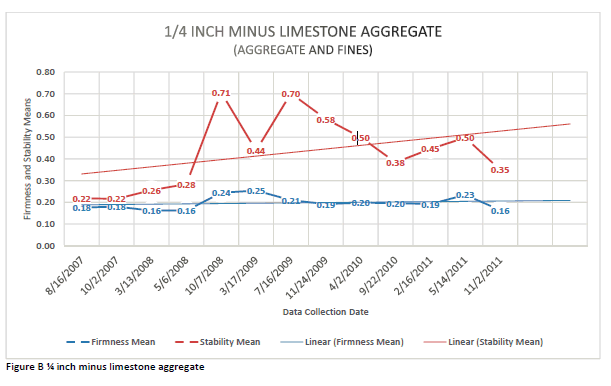
Figure B ¼ inch minus limestone aggregate
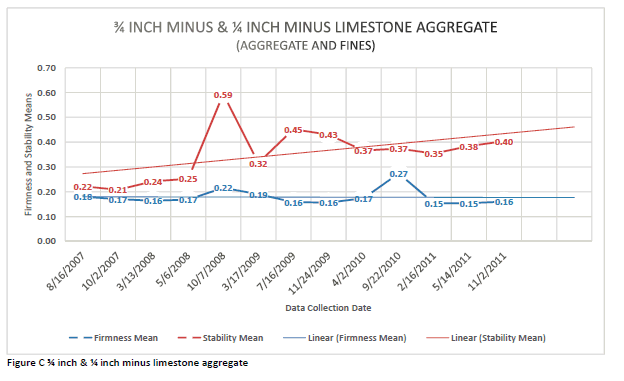
Figure C ¾ inch & ¼ inch minus limestone aggregate
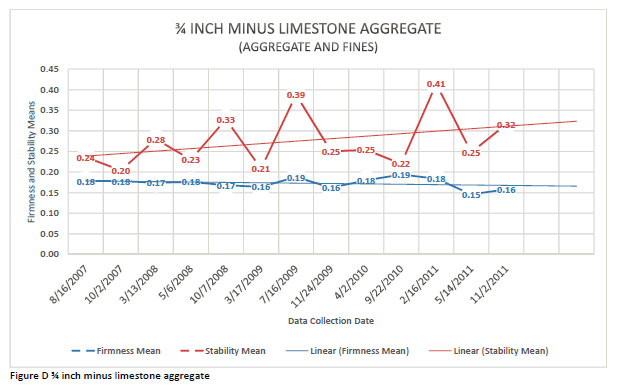
Figure D ¾ inch minus limestone aggregate
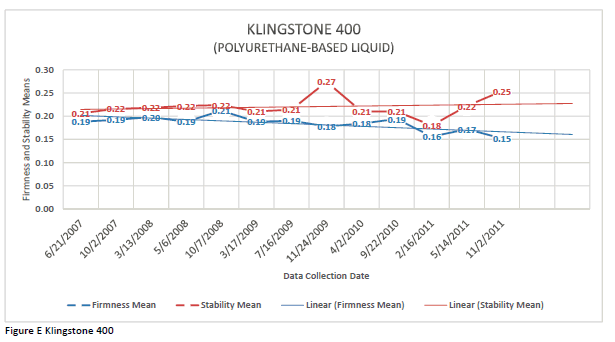
Figure E Klingstone 400
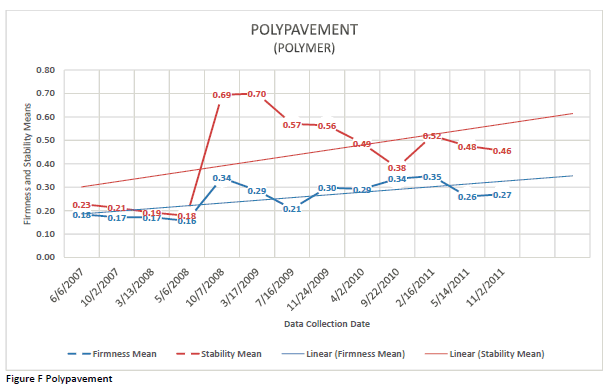
Figure F Polypavement
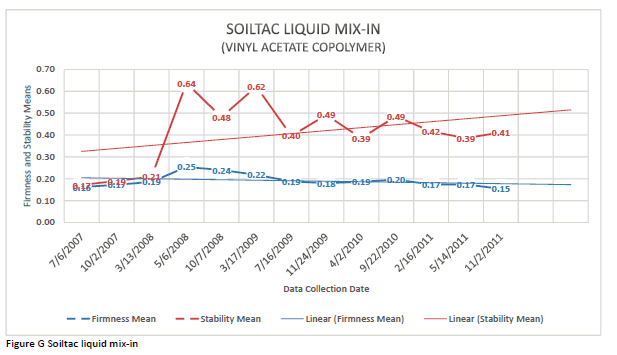
Figure G Soiltac liquid mix‐in
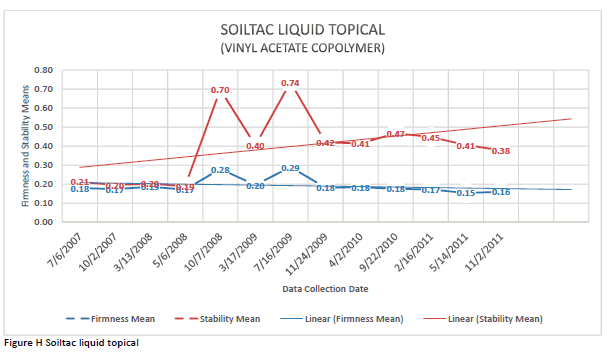
Figure H Soiltac liquid topical
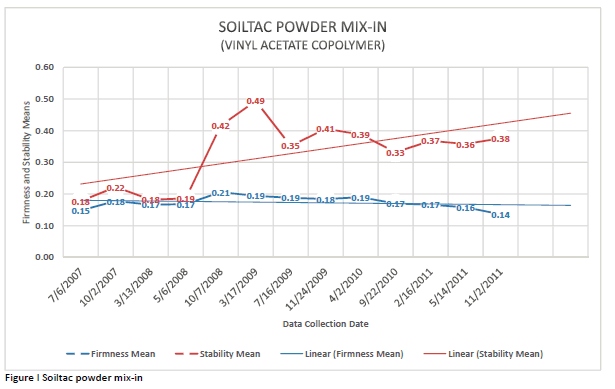
Figure I Soiltac powder mix‐in
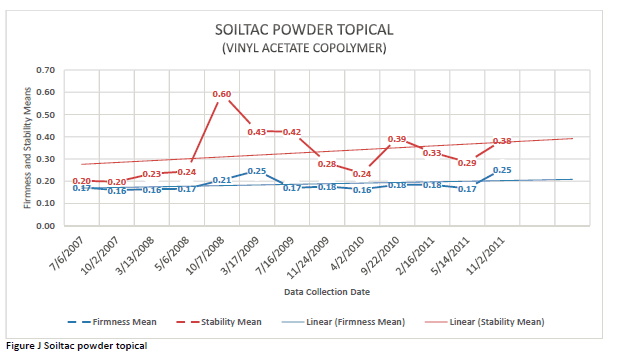
Figure J Soiltac powder topical
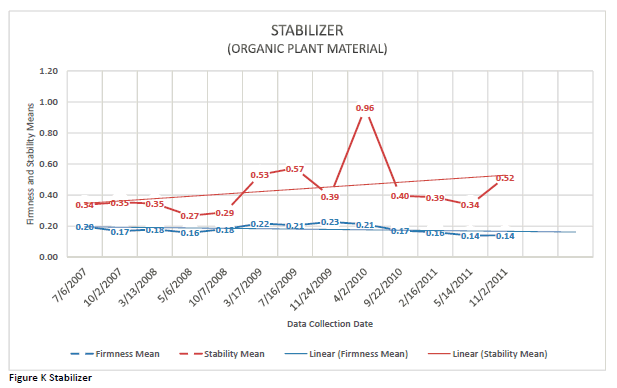
Figure K Stabilizer
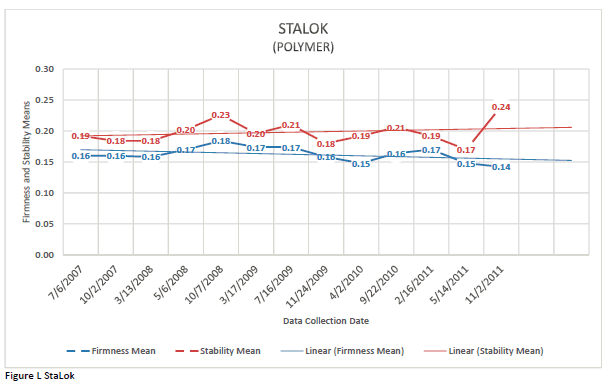
Figure L StaLok
Five different surface compositions make up the 11 various trail surfaces. The following is a breakdown of the five types of surfaces (the make-up of the surface) and the trail surfaces that are included in each:
-
Polyurethane: Klingstone 400
-
Vinyl Acetate Copolymer: Soiltac Liquid Topical, Soiltac Liquid Mix-in, Soiltac Powder Topical, and Soiltac Powder Mix-in
-
Organic Plant Material: Stabilizer
-
Polymer: StaLok and Polypavement
-
Aggregate and fines: ¼ inch minus limestone, ¾ inch minus base and ¼ inch minus top dress limestone, and ¾ inch minus limestone
Utilizing the firmness and stability means of each of the five different surface compositions, a one-way analysis of variance (ANOVA) was run to determine if there was a statistical significance between each of the five different surface composition types. A statistical significance between surface compositions would mean that on average, the surface composition that shows a statistical significance would have maintained a greater degree of firmness or stability over the study period. In order to be statistically significant, the firmness or stability means of one surface composition, when compared to another, would have to be equal to or less than .05. The analysis found that there was a statistical significance in stability between Klingstone 400 (polyurethane), all four Soiltac (vinyl acetate copolymer) surface compositions, the organic plant material, and the ¼ inch minus limestone aggregate surface. To illustrate this point, review Figure M and observe that according to the data collected on five surface compositions over 51 months, it is 95 percent (or .95) certain that the polyurethane surface composition (in this case Klingstone 400) remained more consistently stable than the other three surface compositions (vinyl acetate copolymer, organic plant material, and a ¼ inch minus aggregate surface).
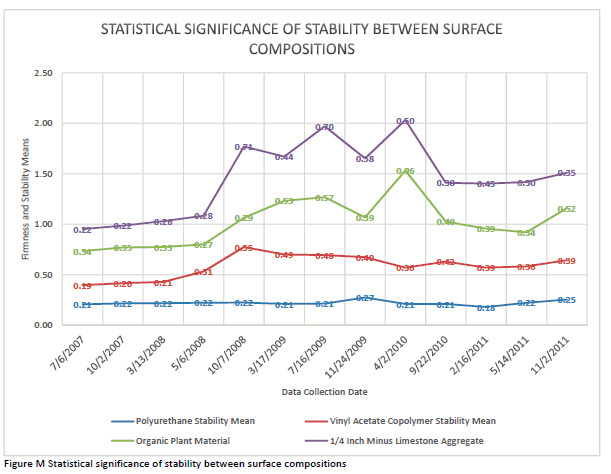
Figure M Statistical significance of stability between surface compositions

User Comments/Questions
Add Comment/Question